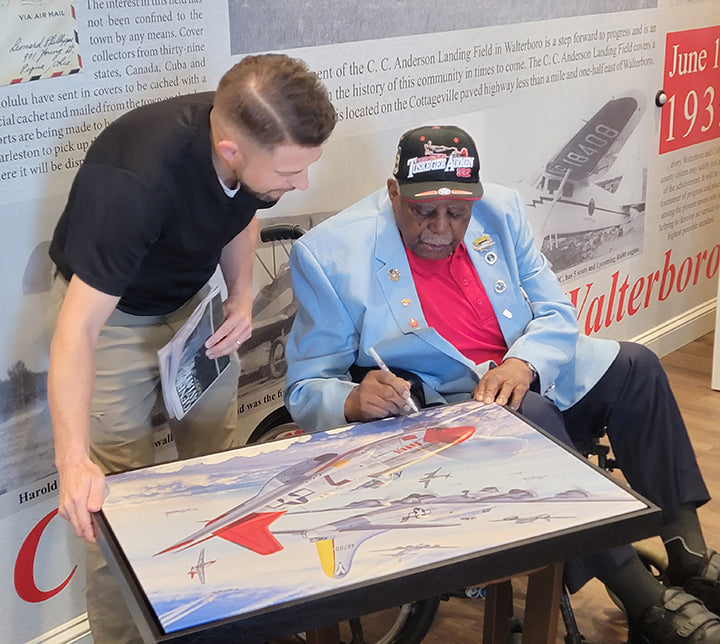This Fine Art Print by Artist Craig Tinder was commissioned by the Hiram E. Mann Chapter of the Tuskegee Airmen of the 332nd Fighter Group in 2023. Artist Craig Tinder illustrated this piece and designed the marble monument at the Walterboro, SC Army Airfield Park. One of the final surviving Tuskegee airmen, 98-year old Dr. Eugene J. Richardson trained in Walterboro at the age of 19 to become a fighter pilot supported the effort.
Created specifically for the monument, this paper print is now available.
 Artist, Craig Tinder, with members of the South Carolina Chapter of the Tuskegee Airmen dedicating the memorial designed by Craig Tinder
Artist, Craig Tinder, with members of the South Carolina Chapter of the Tuskegee Airmen dedicating the memorial designed by Craig Tinder
 Artist, Craig Tinder, with Dr. Eugene J. Richardson, one of the last remaining Tuskegee Airmen with the print "Longest Round Trip".
Artist, Craig Tinder, with Dr. Eugene J. Richardson, one of the last remaining Tuskegee Airmen with the print "Longest Round Trip".
 Artist, Craig Tinder, with Dr. Eugene J. Richardson - Tuskegee Airmen at the dedication ceremony in Walterboro, SC.
Artist, Craig Tinder, with Dr. Eugene J. Richardson - Tuskegee Airmen at the dedication ceremony in Walterboro, SC.
 Dr. Eugene J. Richardson signing the print "The Longest Round Trip".
Dr. Eugene J. Richardson signing the print "The Longest Round Trip".
 Announcement of the rededication ceremony for the Tuskegee Airmen monument.
Announcement of the rededication ceremony for the Tuskegee Airmen monument.
The Story Behind the Print:
On 24 March 1945, the 15th Air Force launched a daring mission that sent 150 heavy bombers deep into the heart of Nazi Germany with the objective of drawing the Luftwaffe away from critical Rhine River crossings. The bombers were accompanied by the 332nd Fighter Group, later known as the legendary Tuskegee Airmen, flying P-51 Mustangs as escort. This mission, a 1,600-mile round trip, was the longest undertaken by the 15th Air Force during World War II.
Despite the distance and challenging conditions, the 332nd Fighter Group proved its mettle when the Luftwaffe launched a desperate defense, deploying several of their cutting-edge Me 262 jet fighters to intercept the bombers. The Me 262, the world’s first operational jet fighter, posed a significant threat to the Allied aircraft with its superior speed and firepower. However, the skilled pilots of the 332nd were ready.
During this intense air battle, the Tuskegee Airmen achieved a major success by downing three of the formidable Me 262s. 1st Lt. Roscoe Brown of the 100th Fighter Squadron, flying his P-51D Mustang Bunnie, claimed his first air-to-air victory by shooting down one of the jets. This victory not only marked a personal achievement for Brown but also highlighted the effectiveness and courage of the Tuskegee Airmen during one of the most challenging missions of the war.
The mission to Berlin demonstrated the strategic importance of the 332nd Fighter Group and their ability to confront and defeat advanced enemy aircraft, solidifying their reputation as some of the finest fighter pilots in the U.S. Army Air Forces.
To purchase or see similar items, visit here.
Commissioned by Museums, Treasured by Collectors





Share:
The Hetzer Tank: A Compact Powerhouse of World War II
The F-14 Tomcat: A Legendary Fighter Jet of the Cold War Era